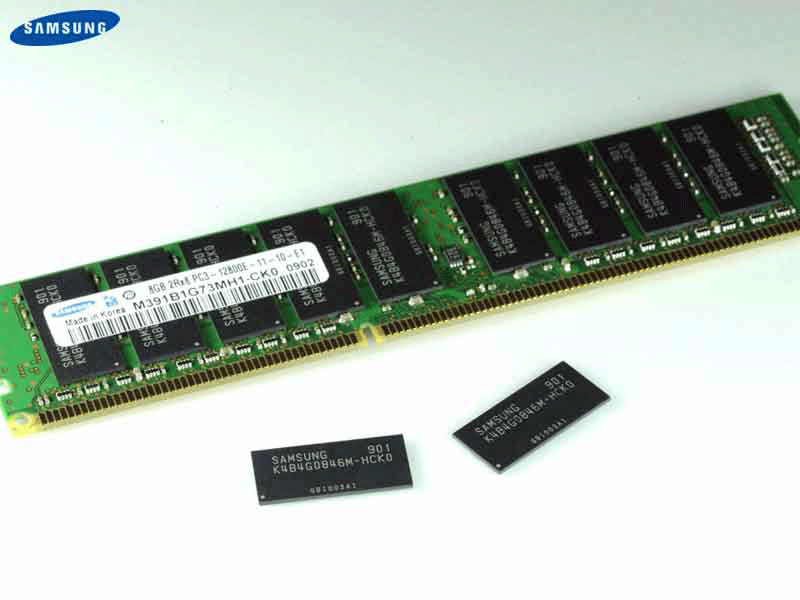Samsung Develops 4Gb DDR3 for 32GB RDIMMs
Samsung announced this week that it has developed the world’s highest density DRAM chip.
Using its 50 nm technology, Samsung has made the world’s first 4 Gb DDR3 DRAM chip. "We have leveraged our strength in innovation to develop the first 4Gb DDR3, in leading the industry to higher DRAM densities," said Kevin Lee, vice president, technical marketing, Samsung Semiconductor, Inc.
"By designing our 4Gb DDR3 using state-of-the-art 50-nm class technology, we are setting the stage for what ultimately will result in significant cost-savings, for servers and for the overall computing market," he added.
The South Korean electronics company said that its low-power 4Gb DDR3 is of the ‘green’ variety, which it is pitching as a selling point to data center managers because it “will not only provide a reduction in electricity bills, but also a cutback in installment fees, maintenance fees and repair fees involving power suppliers and heat-emitting equipment.”
Samsung’s new 4 Gb DDR3 DRAM chips operate at 1.35V, and the company even does the handy math for us by saying it’s a 20 percent improvement over a 1.5V DDR3. Also, its maximum speed is 1.6 gigabits per second (Gbps).
The company goes on to explain that 4 Gb DDR3 can consume 40 percent less power than 2 Gb DDR3 (in the case of 16 GB module configurations) because of its higher density and because it uses only half the DRAM (32 vs. 64 chips).
4 Gb DDR3 can be produced in 16 GB RDIMMs for servers, as well as 8 GB DIMMs for workstations, desktops and laptops. Samsung can then double that number using its dual-die packaging technology, giving a potential 32 GB. How 'bout that?
Get Tom's Hardware's best news and in-depth reviews, straight to your inbox.
-
Pei-chen I guess 4GB DDR3 will be as prevalent as 2GB DDR2 sticks meaning the sweet spot for Win 7 at end of life will be 8GB.Reply -
BigBurn Reply1.35V, and the company even does the handy math for us by saying it’s a 20 percent improvement over a 1.5V DDR3
Sounds more like a 10% improvement to me. -
nekatreven Pei-chenI guess 4GB DDR3 will be as prevalent as 2GB DDR2 sticks meaning the sweet spot for Win 7 at end of life will be 8GB.Reply
"Samsung can then double that number using its dual-die packaging technology, giving a potential 32 GB."
^ The way that it is worded (they mention the packaging technology), they seem to be talking about a single stick of RAM with 32gb on it. I think each chip on the ram is 4GB. They probably wouldn't talk about the potential of a stick of RAM in terms of more than one stick because then, up to a point...the potential is just up to how many sticks you buy.
So using 4 of the 8gb workstation sticks, I think you'd be up at 32gb instead of 8. -
KyleSTL ReplySounds more like a 10% improvement to me.
I thought power consumption was a square of the signal voltage, so (0.9)^2= .81 -
the last resort i think the article is saying that the individual chips are 4GB, so one stick of DDR3 can hold 32GB. So, on some MOBO's, you could have over 128GB of RAM.Reply -
kamel5547 nekatreven"Samsung can then double that number using its dual-die packaging technology, giving a potential 32 GB."^ The way that it is worded (they mention the packaging technology), they seem to be talking about a single stick of RAM with 32gb on it. I think each chip on the ram is 4GB.Reply
Mostly correct..I think everyone is missing the difference between Gb and GB. Each RAM module is made up of severeal chips (now measured in Gb) and the sum total of those chips adds up the modules GB size. Failing to use the proper capitilazation changes the total by a factor of 8 (8 bits in a byte).
-
joex444 The article is correct, each CHIP is 4Gb. Notice the lowercase b, this means bit. 4Gb = 0.5GB = 512MB. You put 8 on a side of a DIMM, that gives you 4GB. You make a double sided DIMM, you'll get 8GB. The article says that for desktop and workstations, you can get 8GB out of it.Reply
To me it sounds like the 32GB sticks would be for servers only, where you can potentially use more chips. I'm not familiar with their "dual die" manufacturing, but I will venture a guess and say they can stick two dies in one chip, producing an 8Gb chip much like Intel sticks two Core2 Duos into a single package and makes a quad core. -
nekatreven Hmm. Yea...I'm plenty familiar with the distinction and the conversion, but no, I hadn't caught that this was gigabits. In fact I was actually thinking how strange it would look for the whole stick of ram to only have a few chips on it. I've never really seen RAM rated in anything but bytes. Good catchReply -
KyleSTL Ram modules (also called sticks) are always rated in MBytes and GBytes (technically MiB and GiB, but we won't get into that here). The memory chips themselves are always rated in Mbits and Gbits.Reply -
enewmen Pei-chenI guess 4GB DDR3 will be as prevalent as 2GB DDR2 sticks meaning the sweet spot for Win 7 at end of life will be 8GB.I was looking for the end of life RAM requirement someplace else. It seems then 8 gig is the most Vista/Win7 will ever fully utilize. So, I can put in 8 gigs, LOCK the case side door and forget about upgrading RAM as long as I'm using Vista/Win7. Same as saying 2 gig is the most XP will ever resonably need.Reply
Anyway, thanks for the unexpected help.

